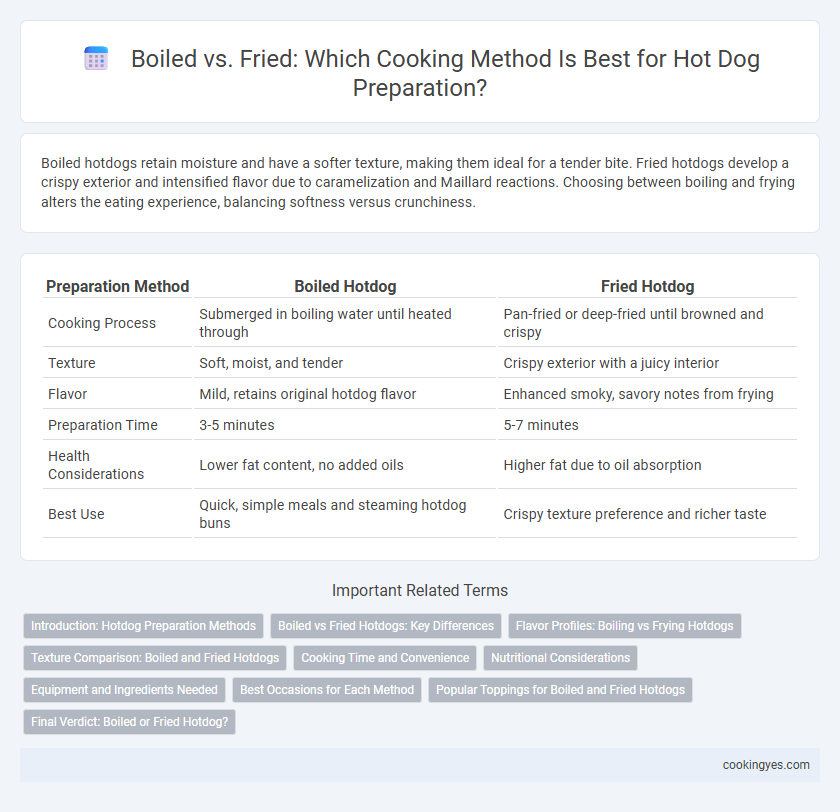Boiled hotdogs retain moisture and have a softer texture, making them ideal for a tender bite. Fried hotdogs develop a crispy exterior and intensified flavor due to caramelization and Maillard reactions. Choosing between boiling and frying alters the eating experience, balancing softness versus crunchiness.
Table of Comparison
| Preparation Method | Boiled Hotdog | Fried Hotdog |
|---|---|---|
| Cooking Process | Submerged in boiling water until heated through | Pan-fried or deep-fried until browned and crispy |
| Texture | Soft, moist, and tender | Crispy exterior with a juicy interior |
| Flavor | Mild, retains original hotdog flavor | Enhanced smoky, savory notes from frying |
| Preparation Time | 3-5 minutes | 5-7 minutes |
| Health Considerations | Lower fat content, no added oils | Higher fat due to oil absorption |
| Best Use | Quick, simple meals and steaming hotdog buns | Crispy texture preference and richer taste |
Introduction: Hotdog Preparation Methods
Boiling and frying are two popular methods for preparing hotdogs, each impacting texture and flavor differently. Boiling ensures even cooking and a juicier hotdog by gently heating it in water, while frying creates a crispier exterior with a richer, caramelized flavor. Selecting the preparation method depends on personal preference and desired taste experience.
Boiled vs Fried Hotdogs: Key Differences
Boiled hotdogs retain a juicier texture and deliver a milder flavor due to gentle cooking in water, preserving the meat's natural moisture. Fried hotdogs develop a crispier exterior and a richer, caramelized taste from direct contact with oil or a hot pan, enhancing the overall savoriness. Choosing between boiled or fried hotdogs impacts the texture, flavor intensity, and mouthfeel, making each method uniquely suited to different taste preferences.
Flavor Profiles: Boiling vs Frying Hotdogs
Boiling hotdogs results in a juicier and milder flavor, preserving the meat's original taste and moisture content. Frying hotdogs enhances a richer, more complex flavor profile by creating a crispy exterior and caramelizing the natural sugars, adding a smoky, savory note. The choice between boiling and frying significantly influences the texture and depth of flavor in hotdog preparation.
Texture Comparison: Boiled and Fried Hotdogs
Boiled hotdogs have a plump, juicy texture with a tender bite due to the gentle cooking process that locks in moisture. Fried hotdogs develop a crispy, slightly charred exterior, offering a satisfying contrast between a crunchy outer layer and a softer interior. The choice between boiled and fried preparation directly impacts the texture experience, with boiling emphasizing moistness and frying enhancing crispiness.
Cooking Time and Convenience
Boiling hotdogs typically takes about 5 to 7 minutes and ensures even heating with minimal attention, making it a convenient method for quick preparation. Frying hotdogs takes slightly longer, around 6 to 8 minutes, but provides a crispier texture and richer flavor due to caramelization. Boiling offers simplicity and speed, while frying requires more active cooking time but delivers enhanced taste and texture.
Nutritional Considerations
Boiling hotdogs retains more water content, resulting in fewer calories and less fat compared to frying, which adds extra oils and increases saturated fat levels. Boiled hotdogs typically contain lower cholesterol and sodium levels due to the absence of oil absorption, making them a slightly healthier option. Frying hotdogs, while enhancing flavor through Maillard browning, can significantly raise calorie count and fat intake, impacting cardiovascular health.
Equipment and Ingredients Needed
Boiling hotdogs requires a pot of water heated to a gentle simmer, ensuring even cooking without added fats, and typically involves minimal equipment such as a stove and saucepan. Frying hotdogs necessitates a skillet or frying pan and a small amount of oil or butter to achieve a crispy exterior, enhancing flavor through Maillard reactions. Essential ingredients for boiling include water and hotdogs, while frying demands oil or butter alongside the hotdogs for optimal taste and texture.
Best Occasions for Each Method
Boiled hotdogs are ideal for casual gatherings like picnics and family barbecues due to their simple, moist texture and quick preparation time. Fried hotdogs, with their crispy exterior and enhanced flavor, suit game day snacks and party appetizers where a more indulgent taste profile is preferred. Choosing between boiled and fried hotdogs depends on the setting, with boiling favored for easy, crowd-pleasing meals and frying reserved for occasions demanding a richer, more textured bite.
Popular Toppings for Boiled and Fried Hotdogs
Boiled hotdogs often feature popular toppings like mustard, ketchup, relish, and chopped onions that enhance their juicy texture. Fried hotdogs, with their crispy exterior, pair well with bold toppings such as sauteed peppers, melted cheese, and crispy bacon bits to complement the crunch. Both preparation methods offer distinct flavor profiles that influence the choice of toppings, making it essential to match toppings for optimal taste.
Final Verdict: Boiled or Fried Hotdog?
Boiled hotdogs retain juiciness and a classic texture, making them ideal for a soft, plump bite. Fried hotdogs develop a crispy exterior and intensified smoky flavor, appealing to those seeking a crunchy contrast. Choosing between boiled or fried depends on preference for tenderness versus crispness, with both methods enhancing the hotdog's savory profile.
Boiled vs Fried for Hotdog Preparation Infographic

 cookingyes.com
cookingyes.com